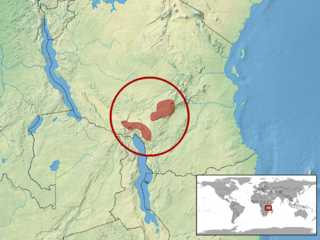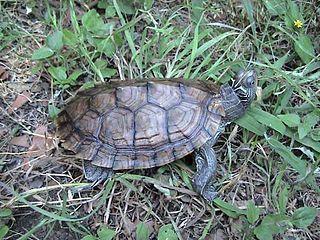
Atheris barbouri is a small and rare terrestrial species of viper endemic to the Uzungwe and Ukinga mountains of south-central Tanzania in Africa. No subspecies are recognized.

Graptemys is a genus of freshwater turtles containing 14 species, commonly known as map turtles. Graptemys are small to medium-sized turtles that are sexually dimorphic, with females attaining as much as twice the length and ten times the mass as males in some species. Depending on the species, adult males range from 7–16 cm (2.75–6.25 in), adult females 10–29.5 cm (4–11.62 in), and hatchlings 2.5–3.8 cm (1–1.5 in), although some sources indicate female Barbour's map turtles grow to 33 cm (13 in) in length. Most species have a distinctive dark pigmented keel that is often notched or serrated running down the center of the carapace and serrated scutes on the rear margin. The head, neck, and limbs exhibit bold patterns of yellow lines and spots against darker green, olive, or black base colors. The patterns on the head can be important characters in identifying the various species. The common name "map turtle" is derived from the intricate patterns on their shells that are suggestive of topographical maps, although the patterns are more apparent in some species than others, and often become obscure in older specimens. Some species are occasionally called "sawbacks", in reference to the serrated keels on their shell.
The long-headed hill rat is a species of rodent in the family Muridae. It is found only in Sulawesi, Indonesia, where it is only known from Mount Tambusisi. Its natural habitat is subtropical or tropical dry forests. It is threatened by habitat loss.

Delany's mouse or Delany's swamp mouse is a species of rodent in the family Nesomyidae. It is the only species in the genus Delanymys and the only extant member of subfamily Delanymyinae, which also contains the fossil genus Stenodontomys. It was previously placed in subfamily Petromyscinae, but it is apparently not closely related to Petromyscus. It is found in Democratic Republic of the Congo, Rwanda, and Uganda. Its natural habitats are subtropical or tropical high-altitude shrubland and swamps. It is threatened by habitat loss.
Barbour's vlei rat is a species of rodent in the family Muridae. It is found in Kenya and Uganda. Its natural habitat is subtropical or tropical high-altitude shrubland. It is threatened by habitat loss.
Petromyscus is a genus of rodent in the family Nesomyidae. It is so distinct from other rodents that it is placed as the only genus in subfamily Petromyscinae. In previous classifications, Delanymys brooksi has also been placed in the subfamily. They are found in southwestern Africa. These animals have a sharp lower point to their V-shaped infraorbital canal. Their molars are intermediate between the ancestral cricetid style tooth and the dendromurine style tooth.
The pygmy rock mouse is a species of rodent in the family Nesomyidae. It is found in Angola, Namibia, and South Africa. Its natural habitat is subtropical or tropical dry shrubland.
The Brukkaros pygmy rock mouse is a species of rodent in the family Nesomyidae. It is found in Namibia and South Africa. Its natural habitat is subtropical or tropical dry shrubland.
Shortridge's rock mouse is a species of rodent in the family Nesomyidae. It is found in Angola and Namibia. Its natural habitat is subtropical or tropical dry shrubland.
The Cameroon soft-furred mouse or Cameroon praomys is a species of rodent in the family Muridae. It is found in Cameroon and Equatorial Guinea. Its natural habitat is subtropical or tropical moist montane forests. It is threatened by habitat loss.
Verschuren's swamp rat is a species of rodent in the family Muridae. It is found only in Democratic Republic of the Congo. Its natural habitat is subtropical or tropical moist lowland forests. It is threatened by habitat loss.
The gray-tailed narrow-headed rat is a species of rodent in the family Muridae. It is found only in Ethiopia. Its natural habitats are subtropical or tropical moist montane forests, subtropical or tropical high-elevation shrubland, and subtropical or tropical high-elevation grassland. It is threatened by habitat loss.

Leptopelis flavomaculatus is a species of frog in the family Arthroleptidae. It is found in the lowlands eastern and southern Africa, from Mozambique north of the Save River and Zimbabwe to Malawi, eastern Tanzania, and coastal Kenya. Its common names are yellow-spotted tree frog, brown-backed tree frog, brown forest treefrog, and Johnston's treefrog.
Nototriton barbouri is a species of salamander in the family Plethodontidae. It is endemic to Honduras.

Barbour's map turtle is a species of turtle in the family Emydidae. The species is native to the southeastern United States.
The ninespot chimaera is a species of chimaera endemic to the waters off Japan and the South China Sea in the Northwest Pacific. Its natural habitat is open seas and its depth range is 100–1,100 metres (330–3,610 ft). It can reach a maximum total length of 60.0 centimetres (23.6 in). Carnivorous in nature and with oviparous reproduction, its eggs are encased in horny shells.

Barbour's seahorse is a species of fish of the family Syngnathidae.
Mixcoatlus barbouri is a venomous pit viper species endemic to Mexico. No subspecies are currently recognized.

Scincella barbouri, also known commonly as Barbour's ground skink, is a species of lizard in the family Scincidae. The species is endemic to China.

Plestiodon barbouri, also known commonly as Barbour's blue-tailed skink and Barbour's eyelid skink, is a species of lizard in the family Scincidae. The species is endemic to Japan.








